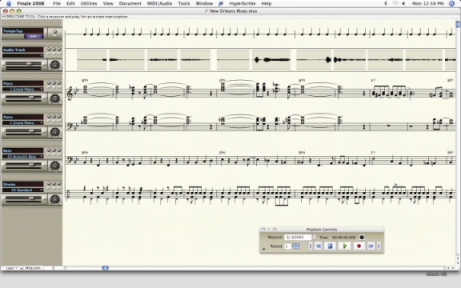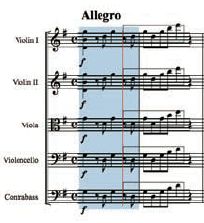
With some software tools, less is more. When it comes to the complexity and breadth of music notation tools, though, more is often more, because everyone’s needs are different. If the “pro”, “high-end” tool happens to do exactly what you need to do efficiently and quickly, that’s the tool you’re most likely to use — even if your notation needs are “modest” in your own eyes. In other words, if you use only 10% of the capabilities of the tool, but everyone’s different 10% is included, you’ve got a winner. And that’s probably part of why two major rivals continue to dominate mindshare in notation, Finale and Sibelius. Finale is on an annual release schedule, compared to Sibelius’ semiannual appearances. 2007 is one of the years the two coincide, with releases shipping almost exactly simultaneously next month.
We took a first peek at what’s new in Sibelius 5: massive plug-in support, an ideas hub, and other enhancements. Here’s what’s doing in Finale 2008 (keeping in mind Finale spreads new features out across annual releases):
Audio recording: This is this year’s banner feature for Finale. You can now import audio and use that as a vocal track in playback or for transcriptions, something not present in any other dedicated notation tool. (Naturally, this is something you can do with a sequencer, but not a scoring-only app.) This wouldn’t be impossible in Sibelius, because Sibelius can import movie files, but Finale does show you the waveform on the score itself.
 Single selection tool, better cut/copy/paste/insert: Finally, Finale does away with its confusing multiple selection tools, choosing instead a single selection tool that does everything, something Sibelius (and most other notation software) have always had. There’s also a new contextual menu that looks more like Sibelius’ classic menu, as well. Now, before you Finale fans start complaining, yes, I recognize Finale has some selection workflows that you may prefer to Sibelius. Sure enough, what Finale 2008 offers that Sibelius lacks is a new set of selection and pasteboard tools that makes it extremely easy to make selections from keyboard shortcuts and drop/adjust placement of inserted music. (See the selection and cut/copy/paste/insert overview.) Back when I did Sibelius trainings, this was a heavily-requested feature, and on first glance, I’d say Finale 2008 may have the superior implementation, though I’ll have to have a closer look. Given that moving notes around is really a big part of composing and arranging, this to me is far more important than plug-in support or audio recording. Sexy? No. Absolutely vital to your work? Probably.
Single selection tool, better cut/copy/paste/insert: Finally, Finale does away with its confusing multiple selection tools, choosing instead a single selection tool that does everything, something Sibelius (and most other notation software) have always had. There’s also a new contextual menu that looks more like Sibelius’ classic menu, as well. Now, before you Finale fans start complaining, yes, I recognize Finale has some selection workflows that you may prefer to Sibelius. Sure enough, what Finale 2008 offers that Sibelius lacks is a new set of selection and pasteboard tools that makes it extremely easy to make selections from keyboard shortcuts and drop/adjust placement of inserted music. (See the selection and cut/copy/paste/insert overview.) Back when I did Sibelius trainings, this was a heavily-requested feature, and on first glance, I’d say Finale 2008 may have the superior implementation, though I’ll have to have a closer look. Given that moving notes around is really a big part of composing and arranging, this to me is far more important than plug-in support or audio recording. Sexy? No. Absolutely vital to your work? Probably.
Styles: Document Styles combine templates with various other assets and engraving settings. It’s quite a lot like Sibelius’ Engraving Rules and templates (heck, the style selection dialog box even looks similar), but it does appear to be more comprehensive than what either program has done in the past.
Mo Playback Features: 2008 expands on the Garritan sound library, and adds expanded human playback support. That’s a far cry from Sibelius 5’s integrated plug-in support, but Finale has more extensive integration of the sounds it already has, as far as playback features and whatnot. The implementation in Finale really is very, very detailed, so you’re more likely to hear little details of your score on playback. There’s new implementation with tools like Garritan’s Stradivarius violin.
Merge multiple scores: If this works as advertised, this could be a huge timesaver — composers working on big projects know exactly what I mean.
Vista compatibility.
The tight race between these tools continues. I am a little disappointed that we’re past the point of real revolutionary tools in actually scoring — the emphasis in both programs has shifted to usability tweaks and playback. Both tools tend to be really weak when it comes to getting off the “grid” of bars and staves and free-handing notation, which is important not only to avant-garde notations, but any user who wants to shift to more of a page layout/illustration software method of working. But for what they are, both tools continue to improve. Composers, arrangers, educators — feel free to chime in.